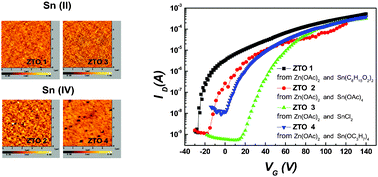In order to study the impacts of precursors on solution-processed metal oxide films and the performance of their field-effect transistors (FETs), zinc acetate dehydrate and four different Sn precursors – tin(II) 2-ethylhexanoate, tin(IV) acetate, tin(II) chloride and tin(IV) isopropoxide – were utilized to prepare zinc–tin oxide (ZTO) thin films by metal–organic decomposition (MOD) and sol–gel processes. Through systematic analysis of these films and devices, it is demonstrated that Sn precursors, with different molecular geometrical configurations and organic ligands, greatly affect the thickness, density, morphology and composition of the ZTO thin films and, hence, the performance of their FETs. It is worth noting that although all of the ZTO thin films are amorphous, the morphologies of the ZTO thin films yielded from Sn(II) precursors, with RMS values below 0.5 nm, are much better than those yielded from Sn(IV) precursors. The ZTO-FET prepared from Zn(CH3COO)2·2H2O and SnCl2 shows a typical field-effect charge carrier mobility of 1.8 cm2 V−1 s−1, with an on/off current ratio of 6 × 105. Our research also indicates that tin(II) 2-ethylhexanoate and tin(IV) isopropoxide are promising Sn precursors for the fabrication of transistors.

